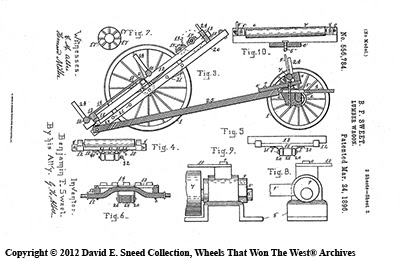Paging through the history of the 19th and early 20th centuries, there were many areas of the U.S. recognized for producing excellent wood-wheeled transportation. Certainly, the state of Wisconsin was no stranger to accolades for quality vehicles. In fact, it was home to a number of major wagon and carriage makers that are still highly touted today. Among those legendary heavy vehicle brands are Mitchell, LaBelle, Bain, Racine-Sattley, Stoughton, Mandt, and Fish Bros. Also included in this list are makers like Northwestern Manufacturing (Fort Atkinson), Vaughn Manufacturing Company (Jefferson), Smith Manufacturing (La Crosse), White Wagon Works (Sheboygan Falls), and B.F. & H.L. Sweet from Fond du Lac, Wisconsin.
While Sweet was a respected brand – with several wagon-related patents to its credit – the company’s influence was predominantly regional in scope. Large scale state fairs, however, gave strong but smaller makers, like Sweet, a platform on the same level with major national brands. Most of the regional firms had nothing to lose and everything to gain by going head-to-head with the large, national brands in these venues. Thus, in 1888, Sweet dared to step into the competitive limelight with numerous other brands at the Wisconsin State Fair in Milwaukee. Showcasing their craftsmanship alongside some of the most powerful names in 19th century transportation, Sweet ultimately found the risk to be worth the rewards.
Like most state fairs of the time, the event was rife with rivalry. Everything from fine art, leather, and textiles to agricultural products, machinery, and household wares like stoves and cabinetry, were judged and awarded prizes. Not to be left out, manufacturers of carriages, wagons and sleighs were also looking for bragging rights. After all, not only did these prominent competitions draw large crowds but they also provided fodder for a great deal of advertising and promotional hyperbole that could be effectively used for years to come. During this state fair, B.F. & H.L. Sweet took first place in a number of areas including the Best Two-Seated Light Sleigh… Best Fancy Lumber Wagon… Best Double Farm Sleigh… and, Second Best Double Farm Sleigh. They also took top honors for the Best Heavy Logging Sleigh.
Finding the higher quality and best collectible, horse-drawn vehicles from the 1800’s and early 1900’s has become more and more difficult. It’s a multi-part challenge based in part on the ability to both recognize notable survivors as well as understand what elements contribute to the vehicle’s long-term importance. Doug Hansen of Hansen Wheel and Wagon Shop recently shared a nice “Sweet” wagon find with us. This exceptional wagon will date to the early 1900’s. It’s in remarkable condition with strong original paint, transfer graphics on the box, and well-defined wood contours. It will make a solid addition to about any early vehicle collection. Our thanks to Doug for passing along these images.






+copy+with+text.jpg)



+sized+with+text+copy.jpg)
